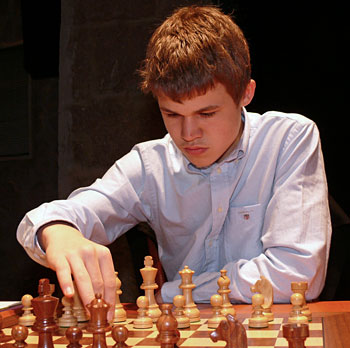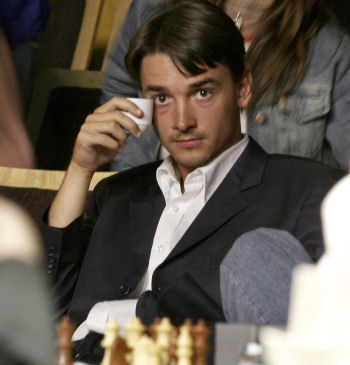| Latest | Greatest | Lobby | Journals | Search | Options | Help | Login |
|
|
|
This topic is archived. |
| Home » Discuss » Topic Forums » Sports |
|
| Jack Rabbit
|
Sun Mar-11-07 09:34 PM Original message |
| The Jack Rabbit Chess Report for March 11: Anand wins Morelia-Linares |
|
Edited on Sun Mar-11-07 10:07 PM by Jack Rabbit
The Jack Rabbit Chess Report for the week ending March 11  from the website of Setn Hall University Contents Post 1: News for the week Post 2: Diagrams and other features Post 3: Games from Current and Recent Events Post 4: Bonus Game: Bobby Fischer vs. Boris Spassky, Match for the World Title, Reykjavik 1972 |
| Printer Friendly | Permalink | | Top |
| Jack Rabbit
|
Sun Mar-11-07 09:35 PM Response to Original message |
| 1. News for the week ending March 11 |
|
Anand wins Morelia-Linares
Grandmaster Vishy Anand of India won the Morelia-Linares Super GM Tournament, which completed yesterday in Linares, Andaluc�a (Spain). The first half of the double-round robin, 14-round category 20 event was held in Morelia, Michoac�n (Mexico).  Vishy Anand and his wife, Aruna, enjoying gaspacho in Morelia Anand scored a total of 8� points out of 14, winning 4, losing one and drawing 9. He finished a full point ahead of the pack. Tied for second were 16-year-old Nowegian grandmaster Magnus Carlsen and Alexander Morozevich of Russia, who each won 4, lost 3 and drew 7. Anand scored one win from Peter Leko of Hungary, who also had a disappointing tournament, but otherwise defeated the two second place finishers, Morozevich once and Magnus twice. He lone loss was at the hands of Armenian GM Levon Aronian, who finished tied for fourth with an even score. Unofficial Cross Table Super GM Tournament Morelia-Linares ------------------------- 1- 2- 3- 4- 5- 6- 7- 8- T- (W) 1 Vishy Anand. . . . . . .-- 11 1� 0� �� �� �� 1� 8� (4) 2 Magnus Carlsen . . . . .00 -- 1� �� �� 11 1� �0 7� (4) 3 Alexander Morozevich . .0� 0� -- �� �1 �1 01 �1 7� (4) 4 Levon Aronian. . . . . .1� �� �� -- �� 0� �� �� 7. (1) 5 Peter Svidler. . . . . .�� �� �0 �� -- �� �� �1 7. (1) 6 Vassily Ivanchuk . . . .�� 00 �0 1� �� -- 1� �� 6� (2) 7 Veselin Topalov. . . . .�� 0� 10 �� �� 0� -- �� 6. (1) 8 Peter Leko . . . . . . .0� �1 �0 �� �0 �� �� -- 6. (1) The Jack Rabbit Unofficial Cross Table uses games won as first tie break Anand's tournament victory combined with the poor showing of former FIDE world champion Veselin Topalov of Bulgaia means that it is expected that Anand will replace Topalov as the world's number one rated player when the quarterly ratings list is released by FIDE on April 1. Anand, who has been second or third on the list for a decade, has never held the top spot. Topalov has held the number one ranking since the retirement of former world champion Garry Kasparov two years ago. Congratulations are also in order to the two second place finishers, Carlse and Morozevich. Young Magnus was playing his in third elite tournament. Magnus failed to win a game in either of two Category 19 events, the Tal Momorial in Moscow in November or the Corus Group A event in Wijk aan Zee, Holland, in January. Magnus got that monkey off his back in the first round in Morelia by by defeating Morozevich. Magnus also defeated Topalov in Morelia when the former FIDE champion misjudged a drawn position and resigned. In addition, Magnus won both his game from Ukranian GM Vassily Ivanchuk. Morozevich put a dent in the rap he has of not being able to do well in elite events, while otherwise having lower rated players for lunch in lesser events. Even more dramatically, Moro (as he is known to his fans) had no wins, three losses and four draws in the Morelia half of the tournament and didn't win a game until defeating Leko in round 9. Moro drew his next two games and then took second place the hard way by winning his last three games in a row against Ivanchuk, Topalov and fellow Russian GM Peter Svidler. |
| Printer Friendly | Permalink | | Top |
| Jack Rabbit
|
Sun Mar-11-07 09:36 PM Response to Original message |
| 2. Diagrams and other features of the JR Chess Report |
|
!""""""""# $tMvWlVmT% $OoOoOoOo% $ + + + +% $+ + + + % $ + + + +% $+ + + + % $pPpPpPpP% $RnBqKbNr% /(((((((() White to move This position is a theoretical draw Does this picture make sense to you? If not, or if it looks like a bunch of Wingdings, please click here. Diagrams used in the Jack Rabbit Chess Report are made with Chess Merida, a true type font that is available as freeware at the above link. Also, the JR chess report makes the main variation in annotations more distinct and readable by putting it in red. A secondary variation, is in blue and other colors are used if needed. |
| Printer Friendly | Permalink | | Top |
| Jack Rabbit
|
Sun Mar-11-07 09:38 PM Response to Original message |
| 3. Games from current and recent events |
|
Edited on Sun Mar-11-07 10:08 PM by Jack Rabbit
Chess Games Analysis by JR and Fritz Vishy Anand - Magnus Carlsen, Super GM Tournament, Round 10, Linares Magnus Carlsen - Vassily Ivanchuk, Super GM Tournament, Round 11, Linares Alexander Morozevish - Peter Leko, Super GM Tournament, Round 9, Linares |
| Printer Friendly | Permalink | | Top |
| Jack Rabbit
|
Sun Mar-11-07 09:55 PM Response to Reply #3 |
| 5. Anand - Carlsen, Super GM Tournament, Round 10, Linares |
 Vishy Anand Vishy Anand vs. Magnus Carlsen Morelia-Linares Super GM Tournament, Round 10 Linares, Andaluc�a (Spain), March 2007 Spanish Grand Royal Game: Chigorin Defense (Keres Variation) 1. e4 e5 2. Nf3 Nc6 3. Bb5 a6 4. Ba4 Nf6 5. 0-0 Be7 6. Re1 b5 7. Bb3 d6 8. c3 0-0 9. h3 Na5
Black: Magnus Carlsen !""""""""# $ +rW Tl+% $+ +vVo+o% $oM O +o+% $+o+pO + % $ P +p+ +% $+b+ Bn+p% $p+ + Pp+% $+ +qR K % /(((((((() White: Vishy Anand Position after 20. Rc1c8:R 20. -- Bxc8?!
Black: Magnus Carlsen !""""""""# $mWt+ +l+% $+ +v+o+ % $o+ O +oO% $+o+pO N % $ P +p+ +% $+b+ + +p% $p+ Q Pp+% $+ + +rK % /(((((((() White: Vishy Anand Position after 26. -- h7h6 27. Ne6!!
Black: Magnus Carlsen !""""""""# $m+t+v+ +% $W + + +l% $o+ OnO O% $+o+pOp+ % $ P + + +% $+b+ + +p% $p+ Q +pL% $+ + +r+ % /(((((((() White: Vishy Anand Position after 31. -- f7f6 32. Re1!
|
| Printer Friendly | Permalink | | Top |
| Jack Rabbit
|
Sun Mar-11-07 09:59 PM Response to Reply #3 |
| 6. Carlsen - Ivanchuk, Super GM Tournament, Round 11, Linares |
 Magnus Carlsen Magnus Carlsen vs. Vassily Ivanchuk Morelia-Linares Super GM Tournament, Round 11 Linares, Andaluc�a (Spain), March 2007 West India Game: Indian Queen's Gambit (Exchange Variation) (Gr�nfeld Defense) 1. d4 Nf6 2. c4 g6 3. Nc3 d5 4. cxd5 Nxd5 5. e4 Nxc3 6. bxc3
Black: Vassily Ivanchuk !""""""""# $t+t+ +l+% $Ov+ WoVo% $ O +o+o+% $M + + +p% $ + Pp+ +% $+ +bB + % $P+ QnPp+% $+ R +rK % /(((((((() White: Magnus Carlsen Position after 16. -- Rf8c8 17. e5!?
Black: Vassily Ivanchuk !""""""""# $ +v+ +l+% $O W +oV % $ Om+oBoO% $+ + P Qp% $ + P + +% $+ +b+ + % $p+ +nPp+% $+ + + K % /(((((((() White: Magnus Carlsen Position after 22. -- h7h6 23. Qc1!
|
| Printer Friendly | Permalink | | Top |
| Jack Rabbit
|
Sun Mar-11-07 10:03 PM Response to Reply #3 |
| 7. Morozevich - Leko, Super GM Tournament, Round 9, Linares |
|
In the first eight rounds at Morelia-Linares, Morozevich had no wins, 3 losses and 5 draws, bring up the rear with 2� points. In the final six rounds, Moro scored 4 wins and 2 draws to finish tied for second prize with Magnus Carlsen.
This is Moro's first win in Linares. He also won three games in a row in the last three rounds.  Alexander Morozevich Alexander Morozevich vs. Peter Leko Morelia-Linares Super GM Tournament, Round 9 Linares, Andaluc�a (Spain), March 2007 East India Game: Queen's Indian Defense (Timman Variation) 1. d4 Nf6 2. c4 e6 3. Nf3 b6 4. g3 Ba6
Black: Peter Leko !""""""""# $t+ WtVl+% $Ov+m+o+O% $ O O +o+% $+ Op+ +m% $q+p+ + +% $+ Nb+nP % $pP + Pk+% $R B + +r% /(((((((() White: Alexander Morozevich Position after 15. -- Nf6h5:p 16. Rxh5!?
Black: Peter Leko !""""""""# $t+ + Vl+% $Ov+ + T % $ O + W O% $+ OpO +q% $ + +b+ +% $+ + + Pn% $pP + +k+% $R B + + % /(((((((() White: Alexander Morozevich Position after 25. -- Re7g7 26. Bd2!?
Black: Peter Leko !""""""""# $ + +t+ L% $O + +tV % $ O +n+ W% $+ OpQ R % $ +p+ +pB% $+ + + + % $pP + +k+% $+ + + + % /(((((((() White: Alexander Morozevich Position after 40. -- Kh8g8 41. Rxg7!
|
| Printer Friendly | Permalink | | Top |
| Jack Rabbit
|
Sun Mar-11-07 09:41 PM Response to Original message |
| 4. Bonus Game: Fischer - Spassky, World Title Match, Round 10, Reykjavik 1972 |
|
Edited on Sun Mar-11-07 10:22 PM by Jack Rabbit
Bobby Fischer is 64
Former world champion Bobby Fischer, the greatest American chess player ever, celebrated his 64th birthday Friday. That's one year for each space on a chess board. Anyone who loves chess loves Bobby Fischer, although Fischer goes out of his way to make loving him as difficult as possible. He is a very sick man. A Freudian would have a field day with this man's psyche. He had issues with his mother from childhood; over the years he has publicly broken with his mother (they reconciled before she died several years ago), rejected first the faith and then the ethnic heritage if his forefathers (resulting in some very ugly anti-Semitic statements in recent years), wished harm on the nation of his bith and the city where he grew up and even expressed an inrrational disdain for Queen's pawn openings. While his dark side is twisted and warped, Fischer is not without his virtues. When former world champion Mikhail Tal was forced to drop out of the Cura�ao candidates tournament in 1962 in order to be treated for kidney disease, he expressed disappointment that his fellow Soviet grandmasters did not come to visit him in the hospital, but was greatly pleased that Fischer did. Susan Polgar says that as long as he is not discussing certain subjects, Fischer is a kind gentleman.  Mostly, there is Fischer's art. Imagine Capablanca with a vicious killer instinct. Whether playing Black or White, Fischer always played for a win. He showed his opponets no mercy, even when letting up would seem sporting, such as in shutting out first Taimanov and then Larsen in the matches of the world championship cycle of 1971. His play was unusually crisp and clear, selecting what he thought to be the best move at all times. Fischer had little patience for chess psychology. He simply overpowered his opposition without respect to personality or individual style. His style was also aggressive; as he said of his opponents' pawns and pieces while in his formative years, "I like to see 'em squirm." A Fischer game is a delight. Presneted here is a game from the world championship match against Spassky in 1972. I did not select the 6th game, generally (and rightly) regarded as the best in the match, simply because if Fischer is playing White and opens with something other than 1 e4 it is just isn't a Fischer game. Rather, this is the 10th game of the match, a game that I believe underrated in the Fischer canon. Here's wishing Fishcer enjoyed the day.  Bobby Fischer Bobby Fischer vs. Boris Spassky Match for the World Title, Round 10 Reykjavik, August 1972 Spanish Grand Royal Game: Breyer Defense 1. e4 e5 2. Nf3 Nc6 3. Bb5 a6 4. Ba4 Nf6 5. 0-0 Be7 6. Re1 b5 7. Bb3 d6 8. c3 0-0 9. h3 Nb8
Black: Boris Spassky !""""""""# $t+ T Vl+% $+v+ +oOo% $o+ + + +% $WpO + + % $ + +p+ +% $+ + +n+p% $ +b+ Pp+% $+rQ R K % /(((((((() White: Bobby Fischer Position after 25. -- Qc3xa5 26. Bb3!
Black: Boris Spassky !""""""""# $t+ + V +% $+ +r+ Oo% $ + + L +% $+oO + + % $ + +r+ +% $+ + + +p% $ + + Op+% $+ + + K % /(((((((() White: Bobby Fischer Position after 34. -- Kf7f6 35. Rb7!
Black: Boris Spassky !""""""""# $ + + + +% $+ + + + % $ R + + +% $+ OtLpO % $ R V +p+% $+ + + + % $ + +k+ +% $+ + + + % /(((((((() White: Bobby Fischer Position after 48. -- Kf6e5 49. Kf3!
|
| Printer Friendly | Permalink | | Top |
| DU
AdBot (1000+ posts) |
Mon Apr 29th 2024, 02:35 PM Response to Original message |
| Advertisements [?] |
| Top |
| Home » Discuss » Topic Forums » Sports |
|
Powered by DCForum+ Version 1.1 Copyright 1997-2002 DCScripts.com
Software has been extensively modified by the DU administrators
Important Notices: By participating on this discussion board, visitors agree to abide by the rules outlined on our Rules page. Messages posted on the Democratic Underground Discussion Forums are the opinions of the individuals who post them, and do not necessarily represent the opinions of Democratic Underground, LLC.
Home | Discussion Forums | Journals | Store | Donate
About DU | Contact Us | Privacy Policy
Got a message for Democratic Underground? Click here to send us a message.
© 2001 - 2011 Democratic Underground, LLC